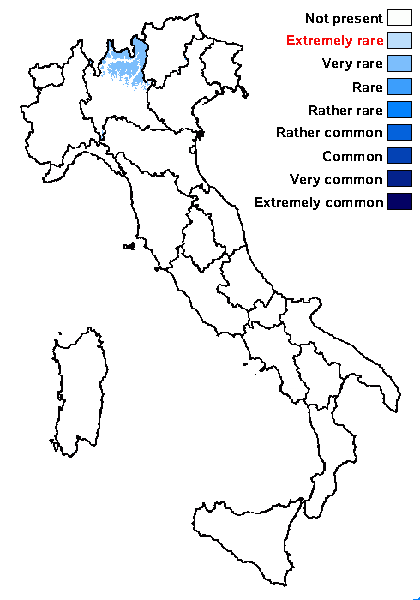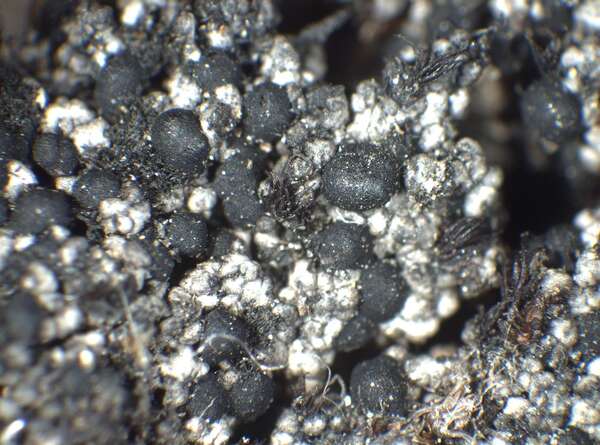Gilbertaria contristans (Nyl.) M. Svensson & Fryday
Mycological Progress: 12, 2022. Basionym: Lecidea contristans Nyl. - Flora, 48: 354, 1865.
Synonyms: Bacidia dufourii (Ach. ex Nyl.) Lettau; Biatora hypocyanea (Stirt.) Zahlbr.; Biatora hypocyanea (Stirt.) Zahlbr.; Biatorina contristans (Nyl.) Arnold; Bilimbia trisepta f. simplicior (Ach. ex Nyl.) Vain.; Catillaria contristans (Nyl.) Zahlbr.; Catillaria dufourii (Ach. ex Nyl.) Vain.; Lecidea dufourii Ach. ex Nyl.; Lecidea sabuletorum f. simplicior Nyl.; Lecidea sabuletorum var. dufourii (Ach. ex Nyl.) Leight.; Thalloidima dufourii (Ach. ex Nyl.) Hav.
Distribution: N - Lomb.
Description: Thallus crustose, episubstratic, rather thick, warty-granular, often cracked, whitish to dark grey, often discoloured and light yellowish brown in old herbarium material, without a distinct prothallus, forming irregular, spreading, up to 2 cm wide patches. Granules (0.05-)0.2-0.5 mm wide, convex to subglobose, contiguous, sometimes proliferating and forming shortly branched, up to 0.8 mm wide areoles which rarely burst open to form blue-green, 0.2–0.3 mm wide soralia. Apothecia biatorine, black, often somehow shiny, crowded and sometimes confluent, (0.2-)0.4-0.8(-1) mm across, with a strongly convex, epruinose disc, without an evident proper margin, initially often with a white byssoid collar at the base. Proper exciple poorly developed, 1.5-2.5 μm wide laterally, colourless or blue green in outer part, composed of radiating, sparsely branched and anastomosing hyphae; epithecium dark green to blue-green, K+ intensifying green. N+ magenta, often with a thin epipsamma; hymenium colourless to greenish in upper part and pale brown in lower part, (35-)60-70 µm high; paraphyses coherent, simple or with numerous short branches, 1.5-2.5(-3) µm thick at mid-level, the apical cells not markedly swollen; hypothecium colourless to pale brown in thin sections, dark reddish brown to brown-black in thick sections, c. 250 µm high. Asci 8-spored, cylindrical-clavate, with a K/I+ blue apical dome penetrated by a narrow, K/I- apical cushion surrounded by a narrow, deeply K/I+ blue zone, the wall K/I- but surrounded by an I+ red-brown and K/I+ blue outer layer, the ocular chamber small, Biatora-type. Ascospores (0-)1(-3)-septate, sometimes slightly constricted at septum, hyaline, ellipsoid to dacryoid (one end rounded, the other pointed), (9-)11-16(-18) x 2.5-4.5(-6) µm. Photobiont chlorococcoid, the cells 7-14 µm wide. Spot tests: thallus K-, C-, KC-, P-, UV-. Chemistry: thallus without lichen substances.Note: on dead bryophytes (Andreaea, Grimmia) and soil rich in humus over acid siliceous rocks in upland areas. For further details see Svensson & Fryday (2022).
Growth form: Crustose
Substrata: soil, terricolous mosses, and plant debris
Photobiont: green algae other than Trentepohlia
Reproductive strategy: mainly sexual
Commonnes-rarity: (info)
Alpine belt: very rare
Subalpine belt: very rare
Oromediterranean belt: absent
Montane belt: very rare
Submediterranean belt: absent
Padanian area: absent
Humid submediterranean belt: absent
Humid mediterranean belt: absent
Dry mediterranean belt: absent

Predictive model
Growth form: Crustose
Substrata: soil, terricolous mosses, and plant debris
Photobiont: green algae other than Trentepohlia
Reproductive strategy: mainly sexual
Commonnes-rarity: (info)
Alpine belt: very rare
Subalpine belt: very rare
Oromediterranean belt: absent
Montane belt: very rare
Submediterranean belt: absent
Padanian area: absent
Humid submediterranean belt: absent
Humid mediterranean belt: absent
Dry mediterranean belt: absent

Predictive model
 INDEX FUNGORUM
INDEX FUNGORUM
 GBIF
GBIF




